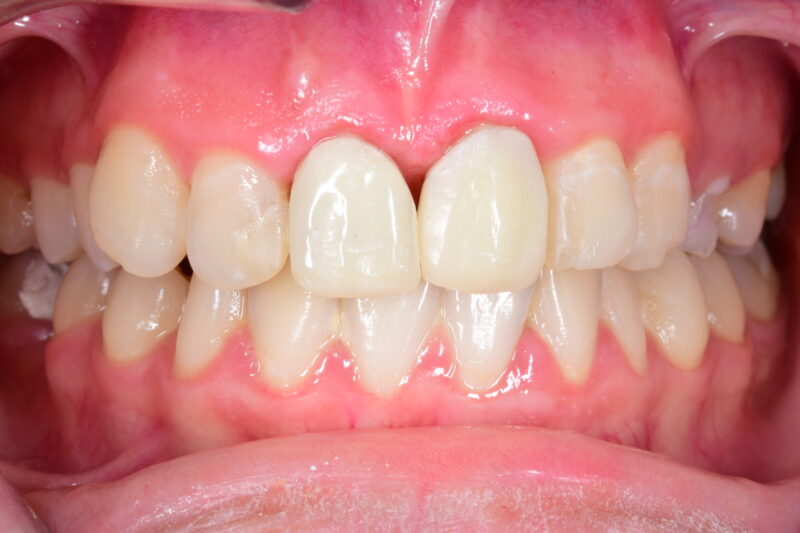Receding gums, also known as gum recession or gingival recession, can be a serious issue for anyone concerned with their oral health. It’s a form of gum disease and refers to when the gum tissue pulls away from the teeth, often causing tooth sensitivity, pain, and even tooth loss if left untreated.
What are receding gums?
Receding gums occur when the gum tissue surrounding the teeth wears away and exposes the root of the tooth. This can be caused by a variety of factors including gum disease, genetics, age, over-brushing, and smoking. When gums recede, it can affect oral health by exposing the tooth root to harmful bacteria, leading to decay, infections, and even tooth loss if left untreated.

Symptoms of receding gums
Gum recession is noticeable in day-to-day life, and you may begin to notice symptoms of receding gums like:
- Tooth sensitivity
- Pain or discomfort when chewing or brushing
- Visible roots of the teeth
- Longer-looking teeth than usual
- Gaps or spaces between teeth
- Changes in the way your teeth fit together when you bite down
- Increased risk of tooth decay and infections
- Bleeding or swollen gums
- Bad breath (halitosis)
You should look out for things like tooth sensitivity or pain when eating, drinking or brushing your teeth, longer-looking teeth than usual, or gaps between your teeth. These symptoms can make day-to-day activities like eating, speaking, and brushing your teeth uncomfortable. You may also notice changes in the way your teeth fit together when you bite down.
In some cases, you may also experience bad breath or swollen gums. If you notice any of these symptoms, it’s important to make an appointment with your dentist as sooner than later to prevent further damage and get the treatment you need.
Causes of gum recession
If your gums are receding, it’s usually due to genetics or your day-to-day lifestyle. Some of the most common causes of gum recession include:
- Gum disease
- Genetics
- Brushing too hard or excessively
- Poor dental hygiene
- Hormonal changes
- Smoking
Gum disease
Gum disease is the most common cause of gum recession. Gum disease is a bacterial infection that can damage the gum tissue and cause it to recede over time.
Gum disease, also known as periodontal disease, is caused by the buildup of plaque and tartar on the teeth.
Plaque is a sticky film of bacteria that forms on the teeth and can harden into tartar if not removed by brushing and flossing. When plaque and tartar accumulate on the teeth, they can irritate and inflame the gums, causing them to become red, swollen, and tender.
If left untreated, the bacteria in the plaque can penetrate deeper into the gum tissue, leading to the breakdown of the gum attachment to the teeth and the bone that supports the teeth. This can ultimately result in gum recession, tooth loss, and other serious oral health problems.
Gum disease can often be caused by:
- Genetics
- Poor oral hygiene
- Smoking
Genetics
Some people may be more predisposed to gum recession due to their genetic makeup. For instance, some individuals may have thinner gum tissues or weaker attachments between the gums and teeth, making them more susceptible to gum recession. Additionally, certain genetic conditions, such as Down syndrome and Ehlers-Danlos syndrome, can also lead to gum disease and gum recession.
If you have a family history of gum disease or gum recession, it is important to be vigilant about maintaining good oral hygiene and attending regular dental checkups to catch any early signs of gum problems.
Overbrushing
Over brushing and brushing your teeth too aggressively can cause the gum tissue to wear away and can lead to gum recession. This is because the excessive pressure applied to the gums can cause them to pull away from the teeth and expose more of the tooth root. Over time, this can weaken the gums and make them more vulnerable to infection and further recession
Poor hygiene
Poor dental hygiene can have a significant impact on the health of your gums. When you don’t brush and floss regularly, plaque and tartar can build up on your teeth and gum line. Plaque is a sticky film of bacteria that forms on the teeth and can cause gum irritation and inflammation. If left untreated, plaque can harden into tartar.
When plaque and tartar accumulate on the teeth and gum line, they can cause gum disease. And as mentioned above, gum disease is an infection of the gum tissue that can cause inflammation, redness, and bleeding– often leading to gum recession.
Hormonal changes
Hormonal changes can affect the body’s response to gum disease and inflammation, which can increase the risk of gum recession.
For example, during pregnancy gum disease can be more common as hormonal changes can cause the gums to become more sensitive and susceptible to inflammation. This can lead to a condition called pregnancy gingivitis, which can cause gum swelling, bleeding, and ultimately gum recession if left untreated.
Similarly, women going through menopause may experience hormonal changes that can lead to gum recession, although the exact mechanisms behind this are not fully understood. Additionally, some hormonal medications, such as birth control pills, may also increase the risk of gum recession.
Smoking
Smoking is a major risk factor for gum disease, which again, is a common cause of gum recession. Smoking can damage the gum tissue and reduce blood flow to the gums, making it harder for the body to fight off infections. Smokers are also more likely to accumulate tartar on their teeth, which can lead to this as well.
Additionally, smoking can interfere with the healing process, making it more difficult for the gums to recover from any damage caused by gum disease or other factors.
Prevent receding gums
Prevention of gum recession aligns with positive oral hygiene. If you’re at risk of, or are concerned about receding gums, you can try the following tips:
- Brush your teeth twice a day using a soft-bristled toothbrush and fluoride toothpaste. Use gentle, circular motions to avoid damaging your gums.
- Floss daily to remove plaque and food particles from between your teeth and along the gumline.
- Use a mouthwash to kill bacteria and freshen your breath.
- Quit smoking, as it can increase your risk of gum disease and other oral health problems.
- Eat a balanced diet that is rich in fruits and vegetables, and limit your intake of sugary and acidic foods.
Visit your dentist regularly for dental check-ups and teeth cleanings.
Treatment of receding gums
Treatment of receding gums depends on the severity of the condition. Mild cases may be treated with improved oral hygiene and regular professional dental cleanings. However, more severe cases may require treatments such as:
Scaling and root planning:
This is a non-surgical deep cleaning procedure that removes plaque and tartar from the teeth and roots. This can help promote gum tissue reattachment and prevent further recession.
Gum grafting:
This restorative dental procedure involves taking tissue from another part of the mouth and attaching it to the affected area to cover exposed roots. This can help reduce sensitivity and improve the appearance of the gums.
Medications:
Antibiotics or antimicrobial mouthwashes may be prescribed to treat the bacterial infection causing gum disease.
For check-ups and treatment of gum recession
It is important to consult with a dentist or periodontist to determine the best course of treatment for receding gums. Additionally, maintaining good oral hygiene practices, avoiding smoking, and addressing any underlying health conditions can help prevent or slow down the progression of receding gums.
If you’re concerned that your gums are receding, and curious to learn more about gum recession or treatment and prevention, please contact us and talk to our friendly team.


